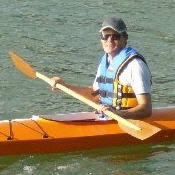The whole point of building the kayaks was to learn a little about the boat building process before tackling something bigger and more expensive. I've read extensively on other blogs, on boat designers web sites and in books borrowed from the library and from friends. Some of the snags I've encountered I've read about previously, because they seem to catch everybody out. I guess that means the first lesson is "There is no replacement for experience. Read all you like, but you don't know until you've done it."
So what are these common problems. The biggest surprise was handling the epoxy resin. It was also the area I had the most apprehension about. A common mistake, apparently is not mixing it thick enough when filleting or bonding. Now I've done that too. The epoxy by itself is about as viscous as maple syrup. It will run pretty much anywhere where its laid deep enough to not get soaked up by the wood grain. To make fillers it is mixed with small, low density spheres that bulk it up, thicken it and make it easier to sand. The spheres actually flow better than the resin, so it takes an awful lot of them to come up with a mix that defies gravity and stays where it is put. For bonding, the spheres are replaces by fibres that are so fine and short they look like dust. These thicken the mix more readily, but again I didn't use enough of them in the early stages. Its quite disheartening to watch that beautiful fillet that you've spent all the allotted 'wet' time shaping start slumping down the bilges into the bottom of the boat, just as the epoxy starts going off into its gel stage where it's no longer workable.
Tools I think I've got just about right. My two planes and my jigsaw get lot and lots of use. My cheap screwdrivers also seem to be getting a fair bit of use, usually while bonding up parts with epoxy, which now covers their handles, so its a good job they were cheap. I'm getting closer and closer to the dreaded sanding stage ready to paint the first boat. This may see some further tool expenditure in the form of an orbital sander. I have a very basic 1/3 sheet sander but it's so poor I usually find it quicker to put a 1/4 sheet round a cork block and use some elbow grease. Watch this space on the verdict of whether a power sander is worth its cost.
On timber, I think I got it right with the plywood, or if anything I maybe bought better than was required or the kayaks. That's by-the-by because anything bigger and of greater value would get the full-on BS1088 Marine Ply spec treatment, its silly to scrimp on the small difference in price per sheet between good ply and the best ply.
Where I got it wrong was with the finger-jointed softwood moulding I bought. Its OK for the inwales, they're really only there to provide a glue surface for the deck. The problem lies when I try to shape the stuff. Its very hard to plane a length of wood when the grain direction changes every 300-450mm. Because the grain changes direction and density, you can't use it to form a fair curve. It would be no good, for example, in forming a batten that was used to hag a plank off to derive the plank's shape. Again, I should have known this because I've read about other builders having trouble with finger-jointed softwood not curving well. Also, its not very strong. The same builders who can't get it to form a fair curve have also had it fail when bending over a tighter radius. I think I'll get some continuous lengths of 18mm square pine for the cockpit stringers before I put the deck on. After all, I've read the warnings from others and I know these parts are under stress when climbing in and out of the boat. It'll be one mistake I'm happy to learn from others making.
Subscribe to:
Post Comments (Atom)

No comments:
Post a Comment